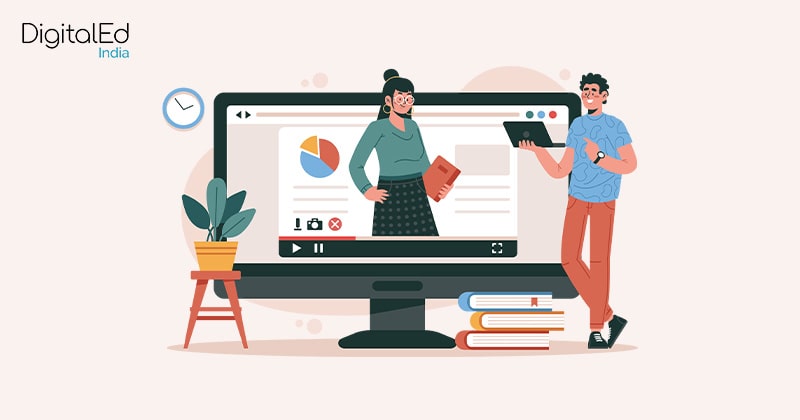Digital Learning: Types, Technology and Methods of Teaching and Learning
Technology is a buzzword today. Undoubtedly, it has taken the world by storm. Every aspect of our life, starting from cooking, communicating, traveling, sports, governance, everything is under the influence of technology. Technology represents dynamism and adapting to this dynamism requires adequate skills. Education is the only way we can equip ourselves and adapt to technological advancements. Hence, education itself cannot lag behind when everything else is being transformed digitally. Technology has brought revolutionary changes in the field of education.

Digital e-learning is a product of technology. However, it is different from online learning or just digital learning. In digital learning, a student learns with the help of digital technologies. It may involve online classes, electronic study materials in the form of audio-video lectures, and textbooks and notebooks for referencing. It is a combination of Blended and virtual learning. On the other hand, Digital e-learning is a learning technique that is totally dependent and facilitated by electronic material. Teachers and students do not meet each other physically and communicate with the help of electronic devices only.
The use of the Internet and innovation of Artificial Intelligence has transformed the world of education and made digital e-learning a possibility. There are several types of digital learning techniques including:
Adaptive Learning – Adaptive learning is a way of learning controlled and guided by Artificial Intelligence. Adaptive Learning comprehends a student’s level of understanding, her strength, and weaknesses based on her response to questions. It then provides systematic delivery of content that is easy for the students to understand.
Badging and Gamification – Badging and gamification is a motivational way of learning where a student is given digital badges for her performance in academics. The incentive of collective badges keeps students motivated toward learning.
E-Textbook – E-textbook is an updated and modern version of traditional textbooks. Numerous research studies by colleges and other educational institutions found that e-textbooks will soon surpass traditional textbooks. e-textbooks are better because they are cost-effective, easy to use and handle, non-perishable, and very easy to update to keep pace with changing scenarios.
Blended Learning – Blended learning is a combination of the best processes of online and traditional methods of learning. Here, teachers teach a student through online classes and by meeting them in in-person classrooms.
Online Learning – Online learning helps a learner advance their learning with the help of the Internet. In online learning, lessons are mostly pre-recorded, and a learner can attend on-demand lectures.
Digital Technologies in The Classroom
Classrooms are becoming modernized with the help of technologies like virtual reality, augmented reality, 3D printing, cloud computing, and social networking. These technologies help keep students engaged in education and save them from any distractions. Teachers have observed that with the help of digital technology, students are able to understand their lessons clearly. It also helps in quick understanding and retention of the topics learned by a student.
Interactive Whiteboards – Interactive whiteboards allow images from a computer to be displayed through a digital projector onto a large wall-mounted board. While using it, one can interact with the content on the board using their fingers or a stylus.
Software Applications – There are multiple applications available to assist students in their learning process. These applications are designed to operate on mobile, tablets, or computers.
The Internet also offers all those services available on the Internet which were not previously available e.g., podcasts, blogs, wikis, etc.
Teaching in a Digital Age
Today, teaching has gone online. The demand for online education has also led to a surge in a platform to equip teachers with skills necessary for teaching online. While teaching in digital age, a teacher needs to keep in mind a few things. What are they?
- Think from a student’s perspective – While taking an online class, it is particularly important for a teacher to think from a student’s perspective. This helps a teacher understand better the needs of the student and what will help the students comprehend a lesson easily.
- Extensive use of technology – In an online class, it is important that a teacher makes effective use of technology that aids online education such as video lectures, animation even movies for subjects like humanities.
Learning in a Digital Age
Learning is as important a skill as teaching. Willingness to learn is the first prerequisite for learning. A learner must be conscious about a few things while learning through a digital medium.
- Remove Distractions – Digital world, like our universe, is limitless. It happens with the learner that they open the Internet for learning but end up wasting a lot of time on irrelevant channels and platforms like social media. However, students need to be determined to stay away from distractions.
- Keep your Sources Limited – There is no dearth of study material online, and that is why it is hard to select valuable resources for targeted learning. However, one must be careful not to overload themselves and keep their learning resources limited.
Digital learning, online learning, or digital e-learning – all these forms of learning provide endless opportunities to learn and grow in life. With the help of digital learning, anyone can learn anything and become an expert in their area of interest. Online learning offers old and young, men and women, an equal opportunity to learn.
What are you waiting for?
Jump on the bandwagon and enroll in your favorite online course.